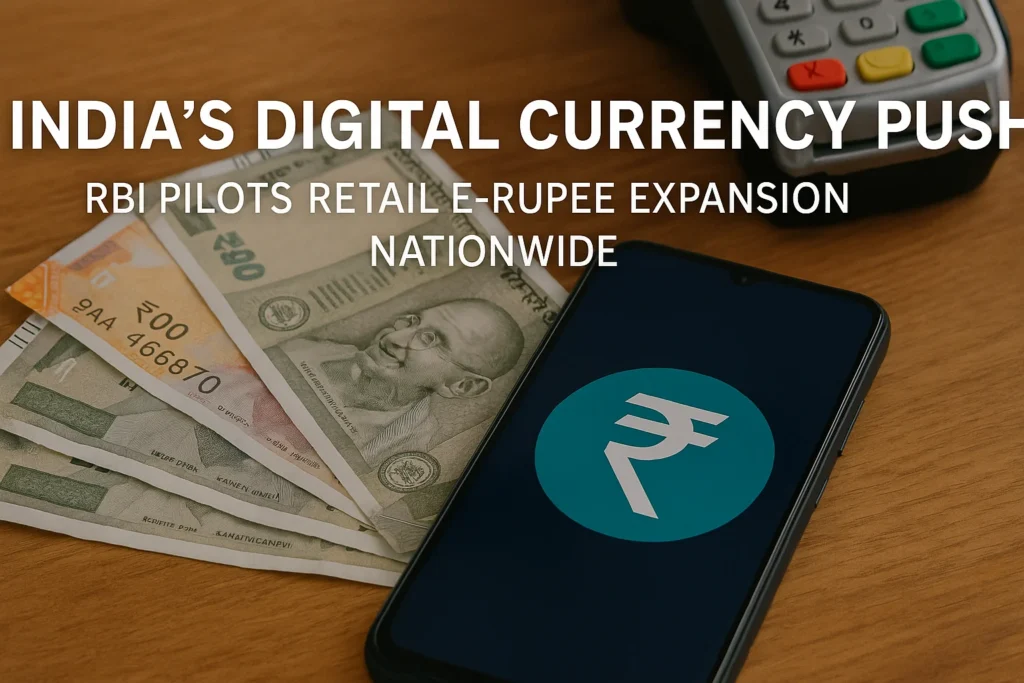Introduction: A New Era for Indian Money
Imagine a world where your everyday cash exists not just in your wallet, but as a secure digital token on your phone, issued directly by the nation’s central bank. In India, this vision is fast becoming a reality. The Reserve Bank of India (RBI) has launched an ambitious new phase of its digital rupee (e₹) rollout, signaling a monumental shift in how millions of citizens handle their money. This isn’t just another payment app; it’s the digital version of India’s official currency, poised to reshape the nation’s financial landscape and potentially set a new global standard.
For a country that has already embraced digital payments with open arms through systems like UPI, the e₹ represents the next frontier. It’s a move by the central bank to modernize money itself, promising to bring down costs, boost transparency, and offer a truly sovereign digital alternative in a rapidly evolving financial world. But like any major transformation, it also sparks conversations about privacy and how this new digital money will interact with the popular payment methods Indians use every day.
The e-Rupee’s Grand Expansion: From Pilot to Pervasive
What began as a quiet experiment in select cities has quickly blossomed into a nationwide endeavor. The RBI’s retail digital rupee (e₹-R) pilot is now expanding its reach, touching more lives and more corners of India than ever before. This expansion is designed to test the digital currency’s robustness and user acceptance on a scale unique among the world’s central bank digital currency (CBDC) projects.
A Growing Footprint
- Millions Embracing Digital Cash: As of May 2025, the e₹ pilot has significantly grown, now involving 17 major banks and reaching an estimated 6 million users across the country. This isn’t just a small test group; it represents a substantial portion of the population actively engaging with the new digital form of currency.
- Beyond the Initial Cities: While the initial pilot in December 2022 started in just four cities, it quickly expanded to 26. The latest push ensures that the e₹ is accessible to a rapidly increasing number of citizens, allowing them to transact with a digital token that holds the same value as the physical rupee. This means that from local kirana shops to larger retail chains, the e₹ is finding its way into everyday transactions. By late June 2025, retail transaction volumes pushed past 1 million, a testament to the growing, albeit still early, adoption.
This scaling up is crucial for the RBI to understand how the e₹ functions in real-world scenarios, gather feedback from users and merchants, and fine-tune its features before a full-scale public launch. It’s a cautious but determined approach to ushering in the future of money.
The UPI Connection: Bridging the Digital Divide
India’s Unified Payments Interface (UPI) has revolutionized digital payments, making instant, seamless transactions a part of daily life for hundreds of millions. As the e₹ expands, a key question arises: how will this new digital currency coexist with the wildly popular UPI system? The answer lies in smart integration and interoperability.
Making Digital Rupee User-Friendly
- Scanning QR Codes: While the e₹ isn’t directly integrated into the core UPI applications in the same way your bank account is, the RBI and its partners are working to ensure practical interoperability. This means that users with an e₹ wallet can easily make payments to merchants by scanning any UPI QR code displayed at retail locations. This familiar “scan and pay” experience, common to UPI users, helps ease the transition to using the digital rupee for everyday purchases.
- Complementary, Not Competing: Experts suggest that UPI and the Digital Rupee are not competitors, but rather complementary tools. UPI acts as a powerful payment rail, connecting different bank accounts and apps. The e₹, on the other hand, is the actual digital form of the currency itself – a direct liability of the central bank. In the future, it’s expected that UPI platforms could evolve to serve as front-end interfaces for using the Digital Rupee, further streamlining the user experience and potentially offering features like offline payments in areas with limited internet connectivity.
This strategic alignment aims to leverage UPI’s immense success and widespread acceptance to accelerate the adoption of the e₹, ensuring that India’s digital payments ecosystem remains robust, efficient, and inclusive.
The RBI’s Promise: Cheaper, Faster, and More Transparent
The Reserve Bank of India isn’t just launching the e₹ for the sake of technological advancement. It has clear objectives for how this digital currency will benefit the economy and its citizens. At its core, the RBI believes the e₹ will lead to significant reductions in transaction costs and usher in a new era of financial transparency.
Economic Advantages in Focus
- Cutting Costs: One of the most compelling arguments for the e₹ is its potential to reduce transaction costs. By being a direct liability of the central bank, the e₹ can minimize the need for intermediaries that typically charge fees for processing payments. This could mean lower transaction fees for businesses and individuals, making digital payments more affordable for everyone. Furthermore, the e₹ could significantly reduce the massive costs associated with printing, distributing, and securely managing physical currency, which runs into crores of rupees annually. This efficiency gain benefits the entire financial system.
- Boosting Transparency: The digital nature of the e₹, built on a secure ledger, allows for greater transparency in financial transactions. Every transaction is logged, providing a clear and traceable record. This inherent traceability is a powerful tool in combating illicit activities like corruption, tax evasion, and money laundering. For example, the e₹ is already being tested for direct benefit transfers (DBTs) in government welfare schemes, ensuring that funds reach the intended beneficiaries without leakages, enhancing accountability and public trust.
- Streamlining Payments: The e₹ facilitates instantaneous transactions and settlements, eliminating the delays often associated with traditional banking systems. This real-time capability not only improves efficiency but also reduces the risks involved in payment processing.
By creating a more secure, cost-efficient, and transparent payment method, the RBI aims to modernize India’s financial system, making it more robust and responsive to the needs of a digital-first economy.
The Privacy Paradox: A Trade-Off?
While the promise of transparency and reduced costs is appealing, the introduction of a central bank digital currency like the e₹ also sparks important conversations about privacy. For many, the idea of a digital currency that is directly traceable by the central bank raises questions about the anonymity traditionally offered by physical cash.
Balancing Oversight and Individual Rights
- Traceability vs. Anonymity: Unlike physical cash, which offers a high degree of anonymity in transactions, the e₹, being a digital record on a ledger, inherently allows for a level of traceability. The RBI itself has indicated that its CBDC aims to promote “non-anonymity of monetary transactions.” This means that while individual transactions might not be openly visible to everyone, the central bank and potentially other authorized entities would have the capability to trace the flow of digital rupees.
- Concerns from Privacy Advocates: Privacy advocates and civil liberties groups have voiced concerns that such traceability could lead to increased government surveillance over citizens’ spending habits. They argue that this might erode financial privacy, allowing for a detailed overview of individual purchases and financial behavior that goes beyond what is currently available through traditional banking systems.
- The RBI’s Stance: The RBI maintains that the e₹ will strike a balance between transparency, which is crucial for combating illicit finance, and user privacy. While the exact technical mechanisms for ensuring privacy while allowing for regulatory oversight are still being refined, the debate highlights a fundamental tension between the convenience and oversight offered by digital currencies and the desire for individual financial autonomy. The hope is that technologies like Zero-Knowledge Proofs (ZKPs) could eventually be incorporated to allow for verification without revealing sensitive transaction details, but these are still under development.
The conversation around e₹ privacy is ongoing, reflecting the complex challenge of designing a digital currency that serves both the needs of the state and the rights of its citizens.
The Players: Banks and Fintechs Join the Digital Push
The ambitious rollout of the e₹ isn’t a solo act by the RBI. It’s a collaborative effort involving a wide array of financial institutions and cutting-edge fintech companies, all working to integrate the digital rupee into India’s vibrant payment ecosystem.
Key Collaborators in the Pilot
- Major Banks at the Forefront: India’s leading public and private sector banks are pivotal to the e₹ pilot. As of early 2025, over 17 banks including giants like State Bank of India (SBI), HDFC Bank, ICICI Bank, Bank of Baroda, Kotak Mahindra Bank, Axis Bank, and Punjab National Bank, are actively offering e₹ wallets to their customers. These banks are responsible for onboarding users, managing the digital wallets, and facilitating transactions. Their extensive branch networks and customer bases are crucial for the widespread adoption of the e₹. Many banks are also incentivizing their employees to use the digital currency, helping to boost initial transaction volumes.
- Fintech Innovators Step In: Recognizing the power of India’s fintech landscape, the RBI has also brought in key digital payment players. In a significant move in January 2025, fintech firms like MobiKwik and Cred became the first third-party application providers to partner with the RBI for the e₹ pilot. MobiKwik has rolled out its e₹ wallet to Android users, enabling peer-to-peer (P2P) and peer-to-merchant (P2M) transactions using UPI QR codes. Cred has launched a beta version for a limited user base, with plans for programmable merchant payments and integration with Cred Pay in the coming months. These partnerships are vital for leveraging the reach and user-friendly interfaces of popular payment apps to make the e₹ more accessible to millions of digital-savvy Indians.
- The Future with UPI Giants: While the immediate focus has been on specific pilot partners, the eventual involvement of other major UPI platforms like Paytm, PhonePe, and Google Pay is widely anticipated. As the e₹ evolves and its functionalities are refined, their integration would provide an even more seamless experience for the vast majority of Indian digital payment users.
This multi-stakeholder approach ensures that the e₹ not only benefits from the stability of traditional banking but also from the innovation and widespread user adoption driven by India’s thriving fintech sector.
India’s Digital Payment Story: A Global Leader
To truly understand the significance of the e₹ rollout, one must look at India’s already impressive journey in digital payments. The country has transformed from a largely cash-based economy to a global leader in real-time digital transactions, setting a precedent that many other nations aspire to follow.
The Foundation of a Digital Economy
- UPI’s Unparalleled Success: The Unified Payments Interface (UPI), launched in 2016, has been the undisputed champion of India’s digital payment revolution. In April 2025 alone, UPI processed over 14.04 billion transactions worth an astounding ₹20.45 lakh crore (approximately $245 billion). Its interoperability across banks, instant settlement, and user-friendly interface through apps like PhonePe, Google Pay, and Paytm have made it ubiquitous, even for the smallest street vendors.
- Driving Financial Inclusion: UPI has been instrumental in bringing millions into the formal financial system, allowing even those with basic feature phones to engage in digital transactions. This vast digital infrastructure forms a strong foundation upon which the e₹ can build.
- The Next Layer: While UPI is a payment system that moves money between bank accounts, the e₹ is the digital form of the money itself. The RBI envisions the e₹ adding another layer of efficiency, security, and programmability to this already robust digital ecosystem. It offers a direct claim on the central bank, bringing sovereign trust to digital currency transactions.
India’s success with UPI demonstrates its capacity for large-scale digital transformation and its population’s readiness to adopt new payment technologies. This makes it fertile ground for the e₹ to flourish and potentially redefine the very nature of money in the digital age.
A Model for Developing Nations?
India’s journey with the e₹ is being closely watched by central banks and governments around the world, especially in other developing nations. With its unique blend of massive digital adoption, a large unbanked population, and a strong push for financial inclusion, India’s CBDC model could provide a valuable blueprint for others contemplating their own digital currencies.
Lessons and Inspiration
- Addressing the “Unbanked”: Like India, many developing nations grapple with large segments of their population lacking access to formal banking services. The e₹’s design, which aims to be accessible through mobile phones and potentially offline, offers a pathway to financial inclusion that bypasses traditional brick-and-mortar banking infrastructure. This could be a game-changer for economies striving to bring more citizens into the digital economy.
- Lowering Transaction Costs: The promise of reduced transaction costs is particularly attractive to developing economies where high fees can disproportionately impact low-value transactions and reduce the real income of citizens. The e₹’s potential to streamline payments and cut out intermediaries could be a significant economic benefit.
- Enhancing Transparency and Governance: For countries struggling with corruption and illicit financial flows, the enhanced transparency and traceability offered by a CBDC like the e₹ can be a powerful tool for better governance and more efficient delivery of public services and welfare schemes.
- Cross-Border Potential: The RBI’s expressed interest in exploring cross-border functionalities for the e₹, including bilateral and multilateral arrangements, could offer an alternative to traditional, often slow and expensive, international payment systems. This could facilitate trade and remittances, especially for developing nations seeking to reduce reliance on dominant global currencies.
As India continues to refine its e₹ model, its experiences—both successes and challenges—will undoubtedly serve as a crucial case study, influencing the design and implementation of digital currencies across the developing world. The world is watching to see if India’s digital rupee can truly become a template for future financial innovation.
Conclusion: India’s Leap Towards a Digital Financial Future
The Reserve Bank of India’s nationwide pilot of the retail e-rupee marks a pivotal moment in India’s ongoing digital revolution. With the e₹ now accepted at a rapidly expanding number of retail locations and UPI integration being tested to ensure smooth use, the digital rupee is steadily weaving its way into the fabric of daily life. The RBI’s claims of reduced transaction costs and increased transparency paint a picture of a more efficient and accountable financial system.
However, the journey is not without its nuances. The discussions around privacy advocates raising concerns over traceability of purchases highlight the critical balance that needs to be struck between financial oversight and individual autonomy. The active participation of major banks and fintech firms like MobiKwik and Cred (with potential for PhonePe, Google Pay, and Paytm to follow) underscores a collaborative approach to this digital transformation.
As India solidifies its position as a global leader in digital payments, its ambitious e-rupee model offers compelling lessons. The world is watching to see if this model could influence other developing nations, providing a blueprint for modernizing financial ecosystems and fostering greater financial inclusion. India’s digital currency push isn’t just about a new way to pay; it’s about reshaping the very nature of money for a digitally empowered future.



